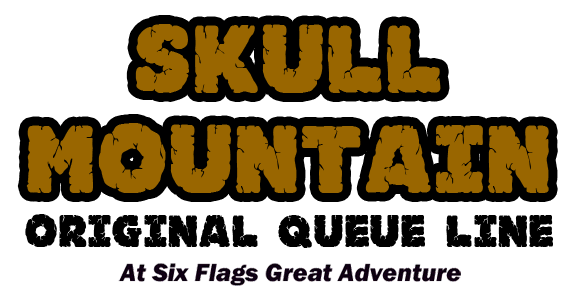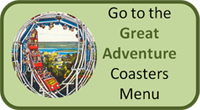
Guests who visit theme parks enjoy immersing themselves into rides and
attractions that will take them to fanciful and exotic locales but
unfortunately the ride experience is usually over in just a couple of
minutes. Realizing that park patrons spend much more time waiting
for these rides rather than on the ride itself, theming and
entertainment is now often incorporated into the queue line, setting the
scene and peaking the interests of riders long before they step into their
ride vehicles.
|
|
|
 |
| |
|
|
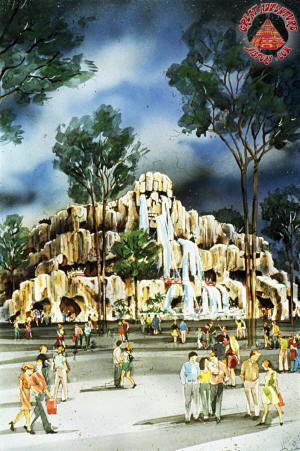 |
 |
| |
|
|
Following a string of extensively themed attractions which included
Batman The Ride, the Right Stuff Mach 1 Adventure, and the Viper, Six
Flags Great Adventure introduced its first indoor roller coaster for the
1996 season. Located next to the highly successful and impeccably
themed Adventure Rivers water ride area, Skull Mountain, with its massive
human skull-topped peak and three tiered waterfall, beckoned riders to
temp fate and discover what mysteries lurked inside its simulated stone
edifice.
However, long before stepping foot inside the cavernous structure which
housed the roller coaster attraction, guests were sent on an adventurous
trek through the outskirts of the "mountain" where they learned that
previous explorers may not have been all the successful in learning the
secrets of Skull Mountain. A 1996 excerpt from a press release for
the ride sets the stage as follows:

|
| |
|
|
 |
 |
 |
| |
|
|
|
The primary area used for Skull Mountain's themed queue began as it does
today, following along the left side of the Skull Mountain building.
From there it wrapped to the left behind the neighboring food stand
which was on the site of what is today Panda Express. It then
worked its way around the stand's outdoor patio and filled the space
which now is home to the Jolly Roger ride. The path then
doubled back onto itself and led to the opening in the mountain which
today still serves as the entrance to the structure. |
| |
|
|
 |
The layout for the queue seemed
tucked away from the rest of the park. The entire area was
surrounded in natural branch fencing and the heavy foliage of the lake
front combined with newly planted lush landscaping all helped to create
a jungle themed environment.
Bypassing the lengthy queue was originally not an option as no shortcut
was provided to allow guests to go directly from the entranceway into
the building. And after all, the majority of Skull Mountain's theming
was not in the mountain itself but instead throughout the outdoor queue line.
It was considered an integral part of the story, not to mention a big
part of the park's investment in the ride. |
| |
|
|
 |
 |
 |
|
|
|
|
 |
Construction of the outdoor queue was still in its earliest stages when
opening day 1996 rolled around. Pathways were just beginning to be
defined and land clearing was well underway. The majority of the
construction efforts were still being invested in the massive mountain and the
coaster which it would host.
Even by mid-May, with just a little over a month until opening day, the
majority of themed elements were yet to be installed, let alone any of
the landscaping or detailed props. |
 |
|
|
|
 |
 |
|
|
|
|
 |
 |
 |
| |
|
|
 |
 |
 |
| |
|
|
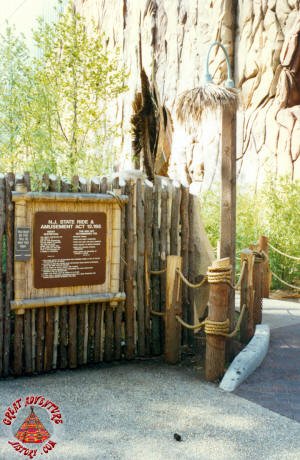 |
Skull Mountain officially opened on June 3, 1996 and guests were greeted
by one of the most elaborate queue line experiences ever offered at the
park. To the beat of native drums and jungle animal squeals,
guests started their journey to Skull Mountain through a meandering
pathway flanked by native shields and colorful totem poles.
Sharpened spears hinted that whoever had claimed this land may not be
that receptive to visitors but brave explorers were encouraged to
venture further, deep into the jungle passages. |
 |
|
|
 |
| |
|
|
 |
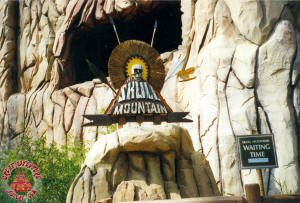 |
 |
| |
|
|
 |
 |
 |
| |
|
|
 |
Never missing an
opportunity to woo hungry adventurers, the park offered one last chance
to purchase rations at the Mountain Dogs food stand. Originally
the Junction Inn, this food facility's windows were dissected by the
ride's perimeter fence making several of its serving windows accessible
to guests waiting in line, while also being available to guests on the
opposite side of the fencing divide.
Just past the food stand, guests turned left behind the facility and
were confronted with the abandoned camp of previous seekers. |
 |
| |
|
 |
 |
| |
|
 |
 |
| |
|
|
 |
 |
 |
| |
|
|
 |
Canvas tents used to protect exploration equipment from the elements
were pitched close to the foot of the mountain. Meanwhile, a
little further into the jungle, thatch huts signaled the presence of
some native tribesmen that may have confronted the explorers.
Located next to this main concentration of props, eager riders were
forced to navigate a three aisle queue house. The permanent queue
bar configuration made traversing its entire length mandatory, but at
least the themed thatched cover provided shade. |
 |
| |
|
 |
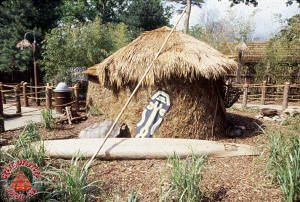 |
| |
|
|
 |
 |
 |
| |
|
|
 |
Once out of the queue
house, a massive cauldron could be heard bubbling away. It was
positioned so that no one could see what was cooking inside, but
everyone had a feeling it was previous guests who sought to challenge
the mountain.
The cauldron itself would outlive the themed queue by many years, often
being used as a prop in Fright Fest shows, haunted hayrides, and terror
trails for seasons to follow. |
 |
| |
 |
| |
|
|
 |
 |
 |
| |
|
|
 |
The final part of the
path paralleled the lakefront where guests once again reentered the
explorers part of the theming. Here, passerby's examined a dig
site which was recently excavated, and a larger tent complete with an
extinguished camp fire that mush have been the temporary home to a
previous intrepid team. Just as guests made the last turn to the
right to head into the mountain, an abandoned truck, which was also used
in later years for Fright Fest, seemed to
careen out of control into the fencing which did not forebode well for our
journeys inside Skull Mountain. |
 |
| |
|
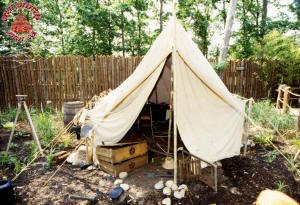 |
 |
| |
|
|
 |
 |
 |
| |
|
|
Skull Mountain's original
themed queue lasted from 1996 through the end of 1998, however, it was
rarely used beyond its first season. The lengthy pathway combined
with the interior passages leading to the station proved superfluous for
the crowds looking to experience Skull Mountain, especially given its
short ride time and relatively high capacity. Before its second
season, a shortcut was added
allowing guests to enter the mountain directly from the main entrance
path, bypassing the need to even enter the themed queue.
The queue line was removed before the 1999 season and replaced by the
Jolly Roger ride. In 2000, the Mountain Dogs food stand was
replaced by a new Wok & Roll indoor restaurant (which is today Panda
Express) occupying the land of the original stand, its neighboring patio
area, and the passages which were once located behind the original
building. Sections of fencing from Skull Mountain's queue are
still visible behind Panda Express.
Today, Skull Mountain is often criticized for its lack of indoor themed
props and scenery during
its near-pitch black ride offering. If only today's explorers knew
of all the theming which once could be discovered just outside
of Skull Mountain. |
 |
| |
 |
| |
 |
| |
|
|
 |
 |

|
 |
 |
 |
